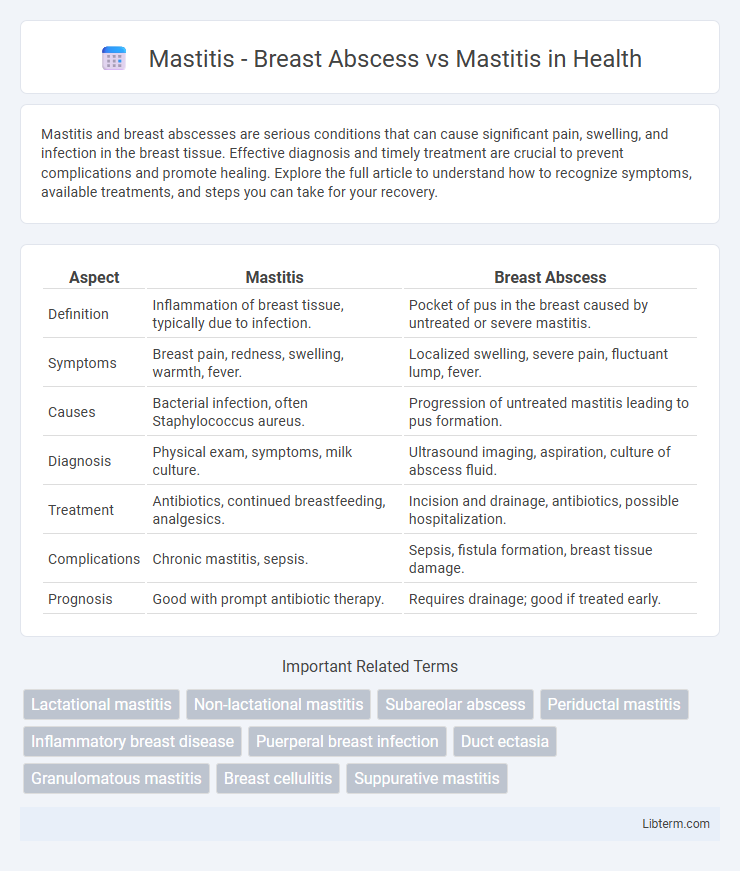Mastitis and breast abscesses are serious conditions that can cause significant pain, swelling, and infection in the breast tissue. Effective diagnosis and timely treatment are crucial to prevent complications and promote healing. Explore the full article to understand how to recognize symptoms, available treatments, and steps you can take for your recovery.
Table of Comparison
| Aspect | Mastitis | Breast Abscess |
|---|---|---|
| Definition | Inflammation of breast tissue, typically due to infection. | Pocket of pus in the breast caused by untreated or severe mastitis. |
| Symptoms | Breast pain, redness, swelling, warmth, fever. | Localized swelling, severe pain, fluctuant lump, fever. |
| Causes | Bacterial infection, often Staphylococcus aureus. | Progression of untreated mastitis leading to pus formation. |
| Diagnosis | Physical exam, symptoms, milk culture. | Ultrasound imaging, aspiration, culture of abscess fluid. |
| Treatment | Antibiotics, continued breastfeeding, analgesics. | Incision and drainage, antibiotics, possible hospitalization. |
| Complications | Chronic mastitis, sepsis. | Sepsis, fistula formation, breast tissue damage. |
| Prognosis | Good with prompt antibiotic therapy. | Requires drainage; good if treated early. |
Introduction to Mastitis and Breast Abscess
Mastitis is an inflammatory condition of the breast, primarily caused by bacterial infection, commonly affecting lactating women and resulting in pain, swelling, redness, and warmth. A breast abscess is a localized collection of pus within the breast tissue that develops as a complication of unresolved or severe mastitis, often requiring drainage in addition to antibiotic therapy. Early recognition and treatment of mastitis are crucial to preventing progression to breast abscess, which involves more invasive interventions and prolonged recovery.
Understanding Mastitis: Causes and Symptoms
Mastitis primarily results from bacterial infection, often Staphylococcus aureus, entering breast tissue through cracked nipples, leading to inflammation characterized by redness, swelling, warmth, and pain. Symptoms include fever, fatigue, and localized breast tenderness, distinguishing mastitis from a breast abscess, which is a more severe complication involving a pus-filled cavity requiring drainage. Early identification and treatment with antibiotics are crucial to prevent progression from mastitis to abscess formation and to alleviate discomfort.
What is a Breast Abscess?
A breast abscess is a localized collection of pus within the breast tissue, usually resulting from a bacterial infection that starts as mastitis and progresses if untreated. It presents as a painful, swollen lump accompanied by redness, warmth, and sometimes fever. Early diagnosis and treatment typically involve antibiotics and drainage to prevent complications and promote healing.
Key Differences: Mastitis vs Breast Abscess
Mastitis is an inflammation of breast tissue often caused by infection, presenting with redness, swelling, and pain, typically responding well to antibiotics and supportive care. A breast abscess develops as a localized collection of pus within the breast, usually resulting from untreated or severe mastitis, characterized by a painful, fluctuant lump requiring drainage for resolution. Key differences between mastitis and breast abscess include the presence of pus formation and the necessity for surgical intervention in abscess cases, whereas mastitis generally resolves with medical treatment alone.
Risk Factors for Developing Mastitis and Abscess
Risk factors for developing mastitis include nipple trauma, milk stasis, and bacterial infection, often occurring during breastfeeding. A breast abscess typically arises as a complication of untreated or severe mastitis, with increased risk linked to delayed treatment, immunosuppression, and diabetes. Understanding these risk factors is essential for early intervention and preventing progression from mastitis to abscess formation.
Diagnostic Approaches for Mastitis and Breast Abscess
Diagnostic approaches for mastitis primarily involve clinical evaluation of symptoms such as breast pain, redness, and swelling, supported by ultrasound imaging to assess inflammation. In cases of breast abscess, ultrasound is crucial for identifying fluid collections, guiding needle aspiration or drainage procedures. Microbiological cultures of breast milk or aspirated fluid help differentiate infectious agents, enabling targeted antibiotic therapy for both conditions.
Treatment Options: Mastitis vs Breast Abscess
Treatment options for mastitis typically include antibiotics such as dicloxacillin or cephalexin and continued breastfeeding to drain the breast. In contrast, a breast abscess requires more invasive intervention like ultrasound-guided needle aspiration or surgical drainage combined with targeted antibiotic therapy to address the pus-filled infection. Prompt identification and differentiation between mastitis and breast abscess are critical for effective treatment and preventing complications.
Complications and Prognosis
Mastitis often leads to localized inflammation and pain, but if untreated, it can progress to a breast abscess, characterized by a pus-filled cavity requiring drainage. Complications of a breast abscess include persistent infection, scarring, and potential disruption of breastfeeding due to tissue damage. Prognosis for mastitis is generally favorable with prompt antibiotic therapy, whereas breast abscesses may necessitate surgical intervention and carry a higher risk of recurrence and prolonged recovery.
Preventing Mastitis and Breast Abscess
Preventing mastitis and breast abscess involves maintaining proper breast hygiene and ensuring effective milk drainage through regular breastfeeding or pumping. Early intervention in cases of blocked milk ducts with warm compresses and increased feeding frequency reduces the risk of infection and abscess formation. Adequate hydration, rest, and prompt medical attention for symptoms like breast pain, redness, and fever are critical to avoid complications.
When to Seek Medical Attention
Mastitis typically causes red, swollen, and painful breast tissue, often accompanied by fever and flu-like symptoms, requiring prompt medical evaluation if symptoms worsen or fail to improve after 48 hours of antibiotic therapy. A breast abscess, a localized collection of pus within the breast, presents as a painful, tender lump and demands immediate medical attention to prevent complications and typically requires drainage. Seek urgent care if you experience severe pain, high fever, or a palpable mass, as timely intervention is crucial to avoid abscess formation and promote effective healing.
Mastitis - Breast Abscess Infographic

 libterm.com
libterm.com